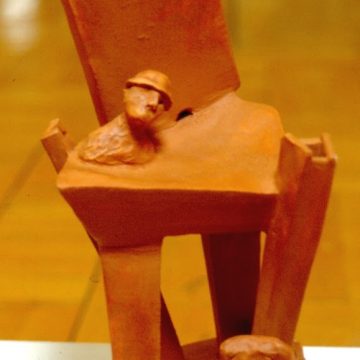Five Stories
photo collage C. Ascher
Art making isn’t just about sudden ideas, immediate visual stimulation or pop-up images. It’s a process: it’s a sequence of thoughts and a series of actions that explore the ways feelings, ideas or inspiration can be married to medium through gesture to go extract the deepest personal meaning they represent. The aim is expression, but it’s also connection, it’s showing, but it’s also sharing.
I recently invited member artists of a local association to create work for an exhibition in response to the theme ‘Fire’. Many of the participants went with the first image that came to their minds as they considered the theme. They approached Fire as an object. Among the works submitted were various versions of these images: cats contemplating a fireplace, people sitting around campfires, still-life images of objects illuminated by candlelight or lamplight.
Others, however, took the creation process further to consider other possibilities. One painter showed a dragon spewing fire, in another’s work a phoenix burst into flames, in a third, candles burned as if for a religious ritual. There were numerous forests being consumed by yellow and red flames (a propos given the forest fires that raged in western Canadian provinces this summer), and volcanoes erupting. They rendered Fire as a subject, broadening it
Then there were images that dug further still not just to describe Fire as an objector or as an action but to capture sensation or emotion. One painter rendered a flamenco dancer at the height of her passion. Another represented hot peppers as they waited on plates or in a shopping basket. A third captured the wisps of smoke from a dying – or igniting – oil lamp wick. A fourth pictured Johnny Cash’s ‘Ring of Fire”. Another showed the burning of a funeral pyre in India, a Sati (or Suttee, a banned practice where a widow burns with her deceased husband).
Some abstracted their Fire. They focused on the way that reds, yellows, blues and other colours interact as a fire burns, on the movement of the flames and on the transparency of the smoke. Neither on object nor subject, they rather focused on expressing the elements of fire through their medium, oil, watercolour or acrylic for instance, and through their usage. The painterly technique itself is what conveyed the image’s meaning.
During a critique of their exhibition, many of the artists revealed that they had little direct or current experience with fire. Candles and fireplaces or memories of long-ago campfires were about the limit of their contact. This led us to a discussion about the levels of thinking involved in the interpretation of an idea in art. As seen from the descriptions above, artists have many choices in considering how they will approach a subject: form the common (or popular), to literal (or descriptive), to representational (descriptive + subtly experiential) to interpretative (personally and expressively experiential) to conceptual (or philosophical and universal). Or all of them combined.
It’s important for artists to understand their relationship to their subjects, just as they understand their relationships to their tools, media, techniques and styles. There is a difference between the image, sensation or emotion that arises out of artists’ lived experiences (being burned by a match as a child, or causing a fire or falling in love before a fireplace for instance) to a subject suggested by observation, contemplation or a call-for-submissions (watching a cat laze before a fire or my imposing a fire theme on artists who have little current or personal experience with it). In other words, are artists approaching their images as an expression of personal truth or as a contemplation of a more objective truth, or both?
The most successful images long-term combine lived/felt experience with a broader, more profound understanding of what that image might convey beyond the obvious or the expected.







